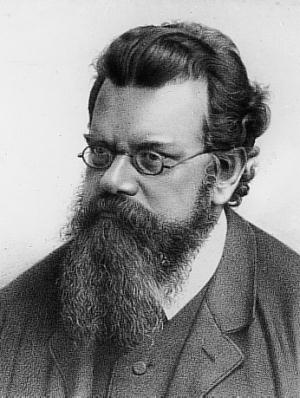Ludwig Boltzmann: atomic genius

By Aussiegirl
Although in real life a broken coffee cup will not unbreak and resume its unbroken state, the laws of physics don't forbid this. The man who first explained this asymmetry, Ludwig Boltzmann, committed suicide a century ago this coming September 5th. The full version of this article is only available to subscribers to Physics World, which I'm not, but here are two links to articles on this subject: Wikipedia has its usual in-depth article here; and here is a review of a biography of Boltzmann written by Carlo Cercignani, the author of this abbreviated article
Ludwig Boltzmann: atomic genius (September 2006) - Physics World - PhysicsWeb
Ludwig Boltzmann: atomic genius
Carlo Cercignani
On the centenary of the death of Ludwig Boltzmann, Carlo Cercignani examines the immense contributions of the man who pioneered our understanding of the atomic nature of matter
Experience teaches us that some processes in life are irreversible. We cannot, for example, travel backwards in time and relive the past, which is why we laugh when we watch a movie run in reverse and see people walking backwards. But the strange fact is that all the fundamental laws of physics are the same, or “symmetric”, whether time runs forwards or backwards. Imagine a coffee cup being knocked off a table and smashing on the floor. No law of mechanics would be violated if the cup were suddenly to reform: there is nothing in principle to stop the broken pieces getting back together, the spilt coffee going back in the cup, and the cup jumping back up onto the table. It is just that there is no chance of this happening.
The man who first gave a convincing explanation of this paradox between the irreversibility of the macroscopic world and the symmetry of the laws of physics was the Austrian physicist Ludwig Boltzmann, who tragically commited suicide 100 years ago this month. One of the key figures in the development of the atomic theory of matter, Boltzmann’s fame will be forever linked to two fundamental contributions to science. The first was his interpretation of “entropy” as a mathematically well-defined measure of the disorder of atoms. The second was his derivation of what is now known as the Boltzmann equation, which describes the statistical properties of a gas as made up of molecules.
The equation, which described for the first time how a probability can evolve with time, allowed Boltzmann to explain why macroscopic phenomena are irreversible. The key point is that while microscopic objects like atoms can behave reversibly, we never see broken coffee cups reforming because it would involve a long series of highly improbable interactions – and not because it is forbidden by the laws of physics.
As Carlo Cercignani explains in the September issue of Physics World, Boltzmann’s ideas had a huge influence on 20th-century physics, even if those ideas had to wait for the likes of Gibbs, Planck and Einstein before they were brought to fruition. But Boltzmann ws also a man full of anxieties who sought perfection in everything he did. When he could not reach the standards he set for himself, he would be overcome by feelings of fear, suffering and depression. It was this that eventually led to his suicide on 5 September 1906.


1 Comments:
Roy -- what a lovey comment. Thanks (blush). You know, the beauty of the internet is that we can be in love with many minds and never have reason to visit the confessional! Come back and visit and by all means leave your comments!
Post a Comment
<< Home